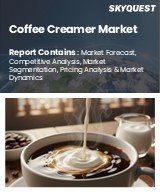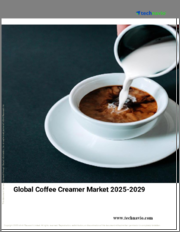
|
시장보고서
상품코드
1722600
비유제품 크리머 시장 보고서 : 원료, 유형, 형태, 유래, 판매 채널, 지역별(2025-2033년)Non-Dairy Creamer Market Report by Origin, Type, Form, Nature, Sales Channel, and Region 2025-2033 |
||||||
세계 비유제품 크리머 시장 규모는 2024년 18억 달러에 달했습니다. 향후 IMARC Group은 이 시장이 2033년까지 28억 달러에 달할 것으로 예상하며, 2025년부터 2033년까지 4.8%의 연평균 성장률(CAGR)을 보일 것으로 전망하고 있습니다. 비건 및 유당이 없는 식품에 대한 수요 증가, 식습관의 변화, 간편식 트렌드의 증가가 시장을 이끄는 주요 요인 중 하나입니다.
비유제품 크리머는 유당이나 유제품 성분을 포함하지 않는 전통적인 크리머를 대체할 수 있는 인기 있는 제품입니다. 비유제품 크리머는 수소 첨가 식물성 기름, 고체 옥수수 시럽, 그리고 크림 같은 질감과 맛을 내는 기타 첨가물로 만들어집니다. 커피, 차, 기타 따뜻한 음료, 요리, 과자 제조에 자주 사용됩니다. 비유제품 크리머의 가장 큰 장점 중 하나는 유당 불내증이나 유제품 알레르기가 있는 사람들에게 적합하다는 것입니다. 또한, 기존 크리머보다 저칼로리, 저지방이기 때문에 체중 조절을 위한 건강한 선택이 될 수 있습니다. 현재 분말형, 액체형, 향료형, 분말형, 액체형, 향료형이 있습니다. 분말 크리머가 가장 일반적이며 바닐라, 헤이즐넛 등 다양한 맛이 있습니다.
비유제품 크리머 시장 동향:
세계 비유제품 크리머 시장은 비건 및 유당이 없는 식품에 대한 수요 증가, 식습관 변화, 편의식품 트렌드 증가 등 다양한 요인에 의해 주도되고 있습니다. 또한, 유제품 크리머와 같은 맛, 질감, 향을 제공하기 위해 베이커리, 제과, 음료 등 다양한 응용 분야에서 비유제품 크리머의 채택이 증가하고 있는 것도 시장 성장에 기여하고 있습니다. 또한, 식물성 제품 소비에 따른 건강상의 이점에 대한 인식이 높아지면서 시장 성장의 원동력이 되고 있습니다. 또한, 혁신적인 제품 포뮬러와 맛의 출현, 유통 채널의 확대, 다양한 포장 형태로 비유제품 크리머의 가용성 증가가 시장 성장에 기여하고 있습니다.
본 보고서에서 다루는 주요 질문
- 2024년 세계 비유제품 크리머 시장 규모는?
- 2025-2033년 비유제품 크리머 세계 시장 성장률 전망은?
- COVID-19가 비유제품 크리머 세계 시장에 미치는 영향은?
- 비유제품 크리머 세계 시장을 주도하는 주요 요인은 무엇인가?
- 비유제품 크리머 세계 시장에서의 원산지별 분류는?
- 비유제품 크리머 세계 시장 형태별 분류는?
- 비유제품 크리머 세계 시장 현황은 어떻게 되는가?
- 비유제품 크리머 세계 시장 판매 채널별 분류는?
- 비유제품 크리머 세계 시장 주요 지역은?
- 비유제품 크리머 세계 시장의 주요 플레이어/기업은?
목차
제1장 서문
제2장 조사 범위와 조사 방법
- 조사 목적
- 이해관계자
- 데이터 소스
- 1차 정보
- 2차 정보
- 시장 추정
- 상향식 접근
- 하향식 접근
- 조사 방법
제3장 주요 요약
제4장 소개
- 개요
- 주요 업계 동향
제5장 세계의 비유제품 크리머 시장
- 시장 개요
- 시장 실적
- COVID-19의 영향
- 시장 예측
제6장 시장 내역 : 원료별
- 아몬드
- 코코넛
- 대두
- 기타
제7장 시장 내역 : 유형별
- 저지방 NDC
- 중지방 NDC
- 고지방 NDC
제8장 시장 내역 : 형태별
- 분말
- 액체
제9장 시장 내역 : 유래별
- 유기농
- 기존
제10장 시장 내역 : 판매 채널별
- 슈퍼마켓과 하이퍼마켓
- 온라인 스토어
- 백화점
- 기타
제11장 시장 내역 : 지역별
- 북미
- 미국
- 캐나다
- 아시아태평양
- 중국
- 일본
- 인도
- 한국
- 호주
- 인도네시아
- 기타
- 유럽
- 독일
- 프랑스
- 영국
- 이탈리아
- 스페인
- 러시아
- 기타
- 라틴아메리카
- 브라질
- 멕시코
- 기타
- 중동 및 아프리카
- 시장 내역 : 국가별
제12장 SWOT 분석
- 개요
- 강점
- 약점
- 기회
- 위협
제13장 밸류체인 분석
제14장 Porter's Five Forces 분석
- 개요
- 구매자의 교섭력
- 공급 기업의 교섭력
- 경쟁 정도
- 신규 참여업체의 위협
- 대체품의 위협
제15장 가격 분석
제16장 경쟁 구도
- 시장 구조
- 주요 기업
- 주요 기업 개요
- Balchem Corporation
- Califia Farms LLC
- Compact Industries Inc.
- Custom Food Group
- Danone S.A.
- Frusela UAB
- Laird Superfood
- Nestle S.A.
- nutpods
- Rich Products Corporation
- TreeHouse Foods Inc.
- Viceroy Holland B.V.
The global non-dairy creamer market size reached USD 1.8 Billion in 2024. Looking forward, IMARC Group expects the market to reach USD 2.8 Billion by 2033, exhibiting a growth rate (CAGR) of 4.8% during 2025-2033. Increasing demand for vegan and lactose-free food products, changing dietary habits, and the rising trend of convenience foods represent some of the key factors driving the market.
Non-dairy creamers are a popular alternative to traditional creamers that contain no lactose or dairy-based ingredients. They are made from hydrogenated vegetable oils, corn syrup solids, and other additives that give them a creamy texture and taste. They are commonly used in coffee, tea, and other hot beverages, as well as in cooking and baking. One of the main benefits of non-dairy creamer is that it is suitable for people with lactose intolerance or dairy allergies. Additionally, they are lower in calories and fat than traditional creamers, making them a healthier option for weight management. Currently, they are available in powdered, liquid, and flavored varieties. Powdered creamers are the most common and are often available in a variety of flavors, such as vanilla and hazelnut.
Non-Dairy Creamer Market Trends:
The global non-dairy creamer market is being driven by various factors, including the increasing demand for vegan and lactose-free food products, changing dietary habits, and the rising trend of convenience foods. Additionally, the growing adoption of non-dairy creamers in various applications, such as bakery, confectionery, and beverages to provide flavor, texture, and aroma like dairy creamers, is bolstering the market growth. Moreover, the surging awareness regarding the health benefits associated with the consumption of plant-based products is providing an impetus to the market growth. Furthermore, the advent of innovative product formulations and flavors, expanding distribution channels, and the increasing availability of non-dairy creamers in different packaging formats are contributing to the market growth.
Key Market Segmentation:
Origin Insights:
- Almond
- Coconut
- Soy
- Others
Type Insights:
- Low Fat NDC
- Medium Fat NDC
- High Fat NDC
Form Insights:
- Powdered
- Liquid
Nature Insights:
- Organic
- Conventional
Sales Channel Insights:
- Supermarkets and Hypermarkets
- Online Stores
- Departmental Stores
- Others
Regional Insights:
- North America
- United States
- Canada
- Asia-Pacific
- China
- Japan
- India
- South Korea
- Australia
- Indonesia
- Others
- Europe
- Germany
- France
- United Kingdom
- Italy
- Spain
- Russia
- Others
- Latin America
- Brazil
- Mexico
- Others
- Middle East and Africa
- The report has also provided a comprehensive analysis of all the major regional markets, which include North America (the United States and Canada); Europe (Germany, France, the United Kingdom, Italy, Spain, Russia, and others); Asia Pacific (China, Japan, India, South Korea, Australia, Indonesia, and others); Latin America (Brazil, Mexico, and others); and the Middle East and Africa. According to the report, Asia Pacific was the largest market for non-dairy creamer. Some of the factors driving the Asia Pacific non-dairy creamer market included the increasing trend of veganism and lactose intolerance among consumers, growing demand for convenience food products, increasing use of non-dairy creamers in the foodservice industry, and rising disposable incomes.
Competitive Landscape:
- The report has also provided a comprehensive analysis of the competitive landscape in the global non-dairy creamer market. Competitive analysis such as market structure, market share by key players, player positioning, top winning strategies, competitive dashboard, and company evaluation quadrant has been covered in the report. Also, detailed profiles of all major companies have been provided. Some of the companies covered include Balchem Corporation, Califia Farms LLC, Compact Industries Inc., Custom Food Group, Danone S.A., Frusela UAB, Laird Superfood, Nestle S.A., nutpods, Rich Products Corporation, TreeHouse Foods Inc., and Viceroy Holland B.V. Kindly note that this only represents a partial list of companies, and the complete list has been provided in the report.
Key Questions Answered in This Report
- 1.What was the size of the global non-dairy creamer market in 2024?
- 2.What is the expected growth rate of the global non-dairy creamer market during 2025-2033?
- 3.What has been the impact of COVID-19 on the global non-dairy creamer market?
- 4.What are the key factors driving the global non-dairy creamer market?
- 5.What is the breakup of the global non-dairy creamer market based on the origin?
- 6.What is the breakup of the global non-dairy creamer market based on the form?
- 7.What is the breakup of the global non-dairy creamer market based on the nature?
- 8.What is the breakup of the global non-dairy creamer market based on the sales channel?
- 9.What are the key regions in the global non-dairy creamer market?
- 10.Who are the key players/companies in the global non-dairy creamer market?
Table of Contents
1 Preface
2 Scope and Methodology
- 2.1 Objectives of the Study
- 2.2 Stakeholders
- 2.3 Data Sources
- 2.3.1 Primary Sources
- 2.3.2 Secondary Sources
- 2.4 Market Estimation
- 2.4.1 Bottom-Up Approach
- 2.4.2 Top-Down Approach
- 2.5 Forecasting Methodology
3 Executive Summary
4 Introduction
- 4.1 Overview
- 4.2 Key Industry Trends
5 Global Non-Dairy Creamer Market
- 5.1 Market Overview
- 5.2 Market Performance
- 5.3 Impact of COVID-19
- 5.4 Market Forecast
6 Market Breakup by Origin
- 6.1 Almond
- 6.1.1 Market Trends
- 6.1.2 Market Forecast
- 6.2 Coconut
- 6.2.1 Market Trends
- 6.2.2 Market Forecast
- 6.3 Soy
- 6.3.1 Market Trends
- 6.3.2 Market Forecast
- 6.4 Others
- 6.4.1 Market Trends
- 6.4.2 Market Forecast
7 Market Breakup by Type
- 7.1 Low Fat NDC
- 7.1.1 Market Trends
- 7.1.2 Market Forecast
- 7.2 Medium Fat NDC
- 7.2.1 Market Trends
- 7.2.2 Market Forecast
- 7.3 High Fat NDC
- 7.3.1 Market Trends
- 7.3.2 Market Forecast
8 Market Breakup by Form
- 8.1 Powdered
- 8.1.1 Market Trends
- 8.1.2 Market Forecast
- 8.2 Liquid
- 8.2.1 Market Trends
- 8.2.2 Market Forecast
9 Market Breakup by Nature
- 9.1 Organic
- 9.1.1 Market Trends
- 9.1.2 Market Forecast
- 9.2 Conventional
- 9.2.1 Market Trends
- 9.2.2 Market Forecast
10 Market Breakup by Sales Channel
- 10.1 Supermarkets and Hypermarkets
- 10.1.1 Market Trends
- 10.1.2 Market Forecast
- 10.2 Online Stores
- 10.2.1 Market Trends
- 10.2.2 Market Forecast
- 10.3 Departmental Stores
- 10.3.1 Market Trends
- 10.3.2 Market Forecast
- 10.4 Others
- 10.4.1 Market Trends
- 10.4.2 Market Forecast
11 Market Breakup by Region
- 11.1 North America
- 11.1.1 United States
- 11.1.1.1 Market Trends
- 11.1.1.2 Market Forecast
- 11.1.2 Canada
- 11.1.2.1 Market Trends
- 11.1.2.2 Market Forecast
- 11.1.1 United States
- 11.2 Asia-Pacific
- 11.2.1 China
- 11.2.1.1 Market Trends
- 11.2.1.2 Market Forecast
- 11.2.2 Japan
- 11.2.2.1 Market Trends
- 11.2.2.2 Market Forecast
- 11.2.3 India
- 11.2.3.1 Market Trends
- 11.2.3.2 Market Forecast
- 11.2.4 South Korea
- 11.2.4.1 Market Trends
- 11.2.4.2 Market Forecast
- 11.2.5 Australia
- 11.2.5.1 Market Trends
- 11.2.5.2 Market Forecast
- 11.2.6 Indonesia
- 11.2.6.1 Market Trends
- 11.2.6.2 Market Forecast
- 11.2.7 Others
- 11.2.7.1 Market Trends
- 11.2.7.2 Market Forecast
- 11.2.1 China
- 11.3 Europe
- 11.3.1 Germany
- 11.3.1.1 Market Trends
- 11.3.1.2 Market Forecast
- 11.3.2 France
- 11.3.2.1 Market Trends
- 11.3.2.2 Market Forecast
- 11.3.3 United Kingdom
- 11.3.3.1 Market Trends
- 11.3.3.2 Market Forecast
- 11.3.4 Italy
- 11.3.4.1 Market Trends
- 11.3.4.2 Market Forecast
- 11.3.5 Spain
- 11.3.5.1 Market Trends
- 11.3.5.2 Market Forecast
- 11.3.6 Russia
- 11.3.6.1 Market Trends
- 11.3.6.2 Market Forecast
- 11.3.7 Others
- 11.3.7.1 Market Trends
- 11.3.7.2 Market Forecast
- 11.3.1 Germany
- 11.4 Latin America
- 11.4.1 Brazil
- 11.4.1.1 Market Trends
- 11.4.1.2 Market Forecast
- 11.4.2 Mexico
- 11.4.2.1 Market Trends
- 11.4.2.2 Market Forecast
- 11.4.3 Others
- 11.4.3.1 Market Trends
- 11.4.3.2 Market Forecast
- 11.4.1 Brazil
- 11.5 Middle East and Africa
- 11.5.1 Market Trends
- 11.5.2 Market Breakup by Country
- 11.5.3 Market Forecast
12 SWOT Analysis
- 12.1 Overview
- 12.2 Strengths
- 12.3 Weaknesses
- 12.4 Opportunities
- 12.5 Threats
13 Value Chain Analysis
14 Porters Five Forces Analysis
- 14.1 Overview
- 14.2 Bargaining Power of Buyers
- 14.3 Bargaining Power of Suppliers
- 14.4 Degree of Competition
- 14.5 Threat of New Entrants
- 14.6 Threat of Substitutes
15 Price Analysis
16 Competitive Landscape
- 16.1 Market Structure
- 16.2 Key Players
- 16.3 Profiles of Key Players
- 16.3.1 Balchem Corporation
- 16.3.1.1 Company Overview
- 16.3.1.2 Product Portfolio
- 16.3.1.3 Financials
- 16.3.1.4 SWOT Analysis
- 16.3.2 Califia Farms LLC
- 16.3.2.1 Company Overview
- 16.3.2.2 Product Portfolio
- 16.3.3 Compact Industries Inc.
- 16.3.3.1 Company Overview
- 16.3.3.2 Product Portfolio
- 16.3.4 Custom Food Group
- 16.3.4.1 Company Overview
- 16.3.4.2 Product Portfolio
- 16.3.5 Danone S.A.
- 16.3.5.1 Company Overview
- 16.3.5.2 Product Portfolio
- 16.3.5.3 Financials
- 16.3.5.4 SWOT Analysis
- 16.3.6 Frusela UAB
- 16.3.6.1 Company Overview
- 16.3.6.2 Product Portfolio
- 16.3.7 Laird Superfood
- 16.3.7.1 Company Overview
- 16.3.7.2 Product Portfolio
- 16.3.7.3 Financials
- 16.3.8 Nestle S.A.
- 16.3.8.1 Company Overview
- 16.3.8.2 Product Portfolio
- 16.3.8.3 Financials
- 16.3.8.4 SWOT Analysis
- 16.3.9 nutpods
- 16.3.9.1 Company Overview
- 16.3.9.2 Product Portfolio
- 16.3.10 Rich Products Corporation
- 16.3.10.1 Company Overview
- 16.3.10.2 Product Portfolio
- 16.3.10.3 SWOT Analysis
- 16.3.11 TreeHouse Foods Inc.
- 16.3.11.1 Company Overview
- 16.3.11.2 Product Portfolio
- 16.3.11.3 Financials
- 16.3.11.4 SWOT Analysis
- 16.3.12 Viceroy Holland B.V.
- 16.3.12.1 Company Overview
- 16.3.12.2 Product Portfolio
- 16.3.1 Balchem Corporation
















